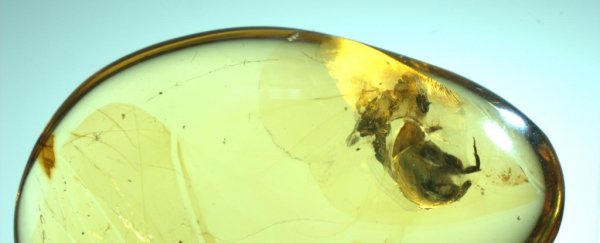A beautifully preserved insect in amber is giving us new insight into the reproductive life of plants from 99 million years ago. The ancient beetle died with its legs coated in pollen, and its remains have now pushed back physical evidence of insect pollination by at least 50 million years.
This could explain how flowering plants, or angiosperms, suddenly boomed in the early Cretaceous - a phenomenon that vexed Charles Darwin, who in 1879 called it an "abominable mystery".
Before this time, angiosperms don't appear on the fossil record. The earliest unequivocal physical evidence of angiosperms is thought to consist of fossilised grains of pollen that are around 130 million years old.
Around 112 to 93.6 million years ago, the angiosperms rose to plant dominance. And, concurrently, so did beetles. Palaeontologists believe the two co-evolved, with insect pollination contributing to the rise of angiosperms, but physical evidence linking them was lacking.
Until now.
From deep in a mine in Myanmar, a newly discovered beetle named Angimordella burmitina seems to have been engulfed in tree resin while in the middle of busily feasting on and pollinating flowers.
 (Nanjing Institute of Geology and Palaeontology)
(Nanjing Institute of Geology and Palaeontology)
Trapped in the amber with the beetle, hidden away under its hairs, researchers from Indiana University Bloomington and the Nanjing Institute of Geology and Palaeontology found some glints of pollen. The natural fluorescence of pollen worked in their favour - the team used a confocal laser scanning microscope to image the dust against the dark insect.
The researchers counted 62 grains of angiosperm pollen, and they say this constitutes excellent evidence that the beetle was a pollinator.
"Our study," they write, "provides direct evidence of insect pollination of Cretaceous flowers, which is further supported by the flower-visiting body shape, specialised pollen-feeding mouthparts, and zoophilous pollen grains."
Through detailed X-ray microcomputed tomography scans, they have linked Angimordella burmitina to modern tumbling flower beetles, or the Mordellidae beetle family. Their traits include a "humpbacked body, deflexed head, pointed abdomen, and stout hind legs," and most of the modern species feed on angiosperm pollen - which is how the researchers were able to recognise the mouthparts.
 (Bao et al., PNAS, 2019)
(Bao et al., PNAS, 2019)
They also analysed the pollen grains for shape, and discovered they are tricolpate: with three grooves on each grain. The shape and structure of the grains indicate that it evolved to cling to insect legs, suggesting that insect pollination was well underway 99 million years ago.
In the last few years, 99 million-year-old Myanmar amber has been providing a wealth of information about this pivotal time in Earth's history. Among other things, palaeontologists have found sea creatures trapped in amber, a snail with preserved soft tissue, really weird bird feathers, dinosaur wings, and the oldest known baby snake fossil.
And now, this new discovery is finally helping unravel Darwin's abominable mystery, 140 years later.
"It's exceedingly rare to find a specimen where both the insect and the pollen are preserved in a single fossil," said biologist David Dilcher of Indiana University Bloomington.
"Aside from the significance as earliest known direct evidence of insect pollination of flowering plants, this specimen perfectly illustrates the cooperative evolution of plants and animals during this time period, during which a true exposition of flowering plants occurred."
The research has been published in Proceedings of the National Academy of Sciences.
